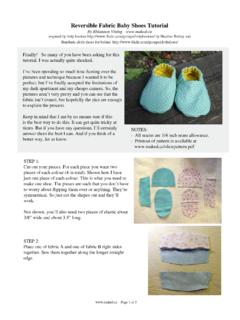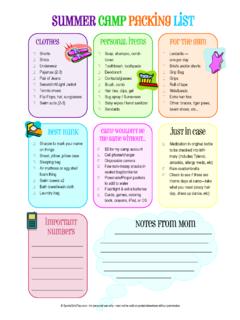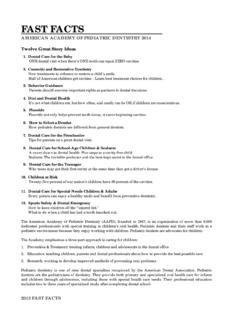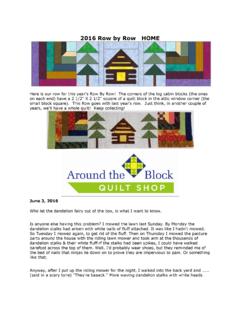Transcription of Weighing a child using a taring scale - WHO
1 Training Course on child Growth Assessment WHO child Growth Standards Job-aid Weighing and Measuring a child Weighing a child using a taring scale Be sure that the scale is placed on a flat, hard, even surface. There must be enough light to operate the solar-powered scale . Explain all procedures to the mother and enlist her help. Babies should be weighed naked; wrap them in a blanket or other covering until Weighing . Older children should be weighed with minimal clothing. If it is socially unacceptable to undress the child , remove as much clothing as possible. If the child is less than 2 years old, do tared Weighing . To turn on the scale , cover the solar panel for a second. When the number appears, the scale is ready.
2 The mother will remove her shoes and step on the scale to be weighed first alone. Have someone else hold the undressed baby wrapped in a blanket. Ask the mother to stand in the middle of the scale , feet slightly apart (on the footprints, if marked), and to remain still. The mother's clothing must not cover the display or the solar panel. Remind her to stay on the scale even after her weight appears, until the baby has been weighed in her arms. With the mother still on the scale and her weight displayed, tare the scale by covering the solar panel for a second. The scale is tared when it displays a figure of a mother and baby and the number Hand the undressed baby to the mother and ask her to remain still. The baby 's weight will appear on the display (shown to the nearest kg).
3 Record this weight. Note: If a mother is very heavy ( more than 100 kg) and the baby 's weight is relatively low ( less than kg), the baby 's weight may not register on the scale . In such cases, have a lighter person hold the baby on the scale . If the child is 2 years or older and will stand still, weigh the child alone. If the child jumps on the scale or will not stand still, use the tared Weighing procedure instead. Ask the mother to help the child remove shoes and outer clothing. Talk with the child about the need to stand still. To turn on the scale , cover the solar panel for a second. When the number appears, the scale is ready. Ask the child to stand in the middle of the scale , feet slightly apart (on the footprints, if marked), and to remain still until the weight appears on the display.
4 Record the child 's weight to the nearest kg. Measuring length or height Depending on a child 's age and ability to stand, measure the child 's length or height. Fixed headboard Movable If a child is less than 2 years old, footboard measure the child 's length lying down (recumbent) using a length board which should be placed on a flat, stable surface such as a table. If the child is aged 2 years or older, measure standing height unless the child is unable to stand. Use a height Movable board mounted at a right angle between a level floor and headboard against a straight, vertical surface such as a wall or pillar. Standing height is about cm less than recumbent length. This difference was taken into account in developing the WHO growth standards.
5 Therefore, it is important to adjust the measurements if length is taken instead of height, Fixed and vice versa. baseboard If a child less than 2 years old will not lie down for measurement of length, measure standing height and add cm to convert it to length. If a child aged 2 years or older cannot stand, measure recumbent length and subtract cm to convert it to height. Preparing to measure length or height Be prepared to measure length/height immediately after Weighing , while the child 's clothes are off. Before Weighing : Remove the child 's shoes and socks. Undo braids and remove hair ornaments if they will interfere with the measurement of length/height. If a baby is weighed naked, a dry diaper can be put back on to avoid getting wet while measuring length.
6 If the room is cool and there is any delay, keep the child warm in a blanket until length/height can be measured. Explain all procedures to the mother and enlist her help. Measuring length Cover the length board with a thin cloth or soft paper for hygiene and for the baby 's comfort. Explain to the mother that she will need to place the baby on the length board herself and then help to hold the baby 's head in place while you take the measurement. Show her where to stand when placing the baby down, opposite you, on the side of the length board away from the tape. Also show her where to place the baby 's head (against the fixed headboard) so that she can move quickly and surely without distressing the baby . Ask her to lay the child on his back with his head against the fixed headboard, compressing the hair.
7 Quickly position the head so that an imaginary vertical line from the ear canal to the lower border of the eye socket is perpendicular to the board. (The child 's eyes should be looking straight up.) Ask the mother to move behind the headboard and hold the head in this position. Speed is important. Standing on the side of the length board where you can see the measuring tape and move the footboard: Check that the child lies straight along the board and does not change position. Shoulders should touch the board, and the spine should not be arched. Ask the mother to inform you if the child arches the back or moves out of position. Hold down the child 's legs with one hand and move the footboard with the other. Apply gentle pressure to the knees to straighten the legs as far as they can go without causing injury.
8 Note: it is not possible to straighten the knees of newborns to the same degree as older children. Their knees are fragile and could be injured easily, so apply minimum pressure. If a child is extremely agitated and both legs cannot be held in position, measure with one leg in position. While holding the knees, pull the footboard against the child 's feet. The soles of the feet should be flat against the footboard, toes pointing upwards. If the child bends the toes and prevents the footboard from touching the soles, scratch the soles slightly and slide in the footboard quickly when the child straightens the toes. Read the measurement and record the child 's length in centimetres to the last completed cm in the Visit Notes of the Growth Record.
9 This is the last line that you can actually see. ( cm = 1. mm). Remember: If the child whose length you measured is 2 years old or more, subtract cm from the length and record the result as height in the Visit Notes. Measuring standing height Ensure that the height board is on level ground. Check that shoes, socks and hair ornaments have been removed. Working with the mother, and kneeling in order to get down to the level of the child : Help the child to stand on the baseboard with feet slightly apart. The back of the head, shoulder blades, buttocks, calves, and heels should all touch the vertical board. Ask the mother to hold the child 's knees and ankles to help keep the legs straight and feet flat, with heels and calves touching the vertical board.
10 Ask her to focus the child 's attention, soothe the child as needed, and inform you if the child moves out of position. Position the child 's head so that a horizontal line from the ear canal to the lower border of the eye socket runs parallel to the base board. To keep the head in this position, hold the bridge between your thumb and forefinger over the child 's chin. If necessary, push gently on the tummy to help the child stand to full height. Still keeping the head in position, use your other hand to pull down the headboard to rest firmly on top of the head and compress the hair. Read the measurement and record the child 's height in centimetres to the last completed cm in the Visit Notes of the Growth Record. This is the last line that you can actually see.

















